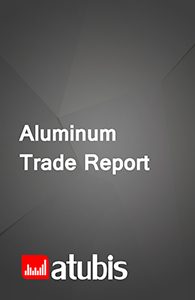Saudi Arabia’s Aluminum Foil Market Outlook Report
7,933€
- TRY: 365,000 ₺
Most of the aluminum foil produced in Saudi Arabia uses continuous casting and rolling. Perishable food and drug packaging as well as disposable containers are the most important applications of aluminum foil. Most of the country’s demand is met through imports, with domestic output taking a small share of the market. Saudi Arabia’s food and drug industry has grown over the years, bolstering demand for aluminum foil.
Product Description
With a GDP of over $792 billion in 2019, Saudi Arabia was the largest economy in the region that year. The country’s economy, the second richest country in terms of natural resources, is heavily dependent on oil, its main natural resource. But since the introduction of the 2030 Vision in 2016, the country has determined to minimize oil reliance. In accordance with the goals defined in the vision, state-owned Ma’aden signed a joint venture agreement with Alcoa for aluminum smelting capacity in 2010; the first primary aluminum was produced in 2013 and before long, the operation was ramped up to full capacity. In the early years, Ma’aden had to import alumina due to technical issues in its alumina refinery as well as the tightness in alumina supply. After 2015, when these issues were resolved and the alumina refinery capacity was completed, alumina imports decreased. The country’s alumina demand is currently met almost entirely from domestic mineral reserves. This minimizes the risk of raw materials for aluminum production to very low levels. As a result, the country’s downstream aluminum part has rapidly developed over the recent years.
Market drivers of aluminum foil
A major portion of aluminum foil output is used as packaging and consumer goods for households. Thus, population directly affects aluminum foil demand. Saudi Arabia’s population is estimated to reach 37.7 million people by 2024, growing 2% on an average annual basis. Population growth remains one of the major demand drivers of packaged products and perishable items, and consequently aluminum foil.
Disposable aluminum containers are widely used by food producers. Polystyrene is also used to produce disposable containers, but there are concerns of collection difficulty (as they tend to be fragile) as well as the long time it takes for them to be naturally decomposed. With the growing drive towards more environmentally friendly solutions, disposable aluminum containers are gaining popularity over their rivals as aluminum is recyclable while other materials used in disposable containers are harmful to the environment.
Overview of Saudi Arabia’s aluminum foil market
A major part of Saudi Arabia’s domestic demand is met through imports, with domestic output taking a small share of the market. The dumping of low-priced Chinese foil in the market has made it difficult for new capacities of foil production in the private sector. Thus, the country is expected to remain a net importer in the remaining years of the forecast period. But, with the increasing availability of raw materials, domestic companies will be able to ramp up operating rates and keep up the uptrend in production. Yet production growth from domestic companies will be lower than realized in the past, which will only slow down the growth of net imports in the coming years.
Breakdown of Saudi Arabia’s aluminum foil market
Domestic demand for aluminum foil in the forecast timeframe as well as the previous period has been broken down using three factors. The first factor breaks down the market into three categories based on alloy material: commercially pure aluminum, heat-treatable alloys, and non-heat-treatable alloys. Past and future trends for each type of material have been analyzed. Non-heat-treatable alloys hold the largest share of the market. In the second breakdown, products are divided into three categories based on thickness: <30μm, between 30μm and 150μm, and >150μm, with medium-thick foil taking a major share of the market. Finally, using the third factor, aluminum foil is categorized based on its applications in different industries. The packaging industry is the largest consumer of aluminum foil in Saudi Arabia.
Key players in Saudi Arabia’s aluminum foil market:
- Ramat Factory
- Abdullah Shamsan Industrial Group
- Saudi Factory for Aluminum Foils and Containers
Additional Information
| Industry | Aluminium Flats |
|---|---|
| Region | Saudi Arabia |
| Report Type | Industry Report |
Specifications
| Report Attribute | Details |
| The base year for estimation | 2020 |
| Historical data | 2010-2019 |
| Forecast period | 2020-2025 |
| Quantitative units | Value in USD and Volume in Tonne |
| Report coverage | Market Overview, Dynamics, Market Outlook, Risks to Forecast, Consumer Market, Industry Overview, Market Landscape, Competitive Landscape, Market Attractiveness, External Macro Environment Analysis |
| Segments covered | Composition, Type, Application |
| Pricing and purchase options | Please explore our purchase options to meet your exact research needs. |
Reasons to Buy
- Recognize the geographical distribution of import demand
- Identify the current and future key players of the trading market
- Achieve a better insight on potential target markets
- Understand the behavior of major suppliers/customers either globally or regionally
- Identify competitors as a feed for market analysis
Table of Content
- Executive summary
- Introduction
- Objective
- Market under study
- Product
- Product specifications
- Consumption structure
- Applications
- Physical properties
- Subjects discussed
- Geographical scope under study
- Study timeframe
- Study currency
- Potential audience
- Market dynamics
- Market drivers
- Restraints
- Opportunities
- Challenges
- Market overview
- Market size
- Industry capacities
- Existing capacities
- Capacity distribution
- Geographical distribution of capacities
- Future capacities
- Existing capacities
- Output
- Output trends
- Operating rates
- Consumption
- Consumption trend
- Consumption Share of domestic product
- Trade
- Exports
- Imports
- Trade balance
- Market balance
- Market breakdown by product type
- Market breakdown by product type
- Market breakdown by application
- Inventory
- Producers inventory
- Consumers inventory
- Traders inventory
- Market outlook
- Market factors
- Raw materials
- Costs and prices
- Competition
- The government
- Other factors
- Future scenarios
- Risks to forecast
- Market factors
- Consumer markets
- End-user markets
- Building construction
- Infrastructure construction
- Transportation manufacturing
- Industrial equipment manufacturing
- Durable goods manufacturing
- Consumable goods manufacturing
- Direct consumer markets
- Major Direct consumers
- Existing capacities
- Drivers
- Major Direct consumers
- End-user markets
- Export potentials
- Destinations
- Trade and insurance costs
- Import market suppliers
- Producers potential share
- Destinations
- Industry overview
- Raw materials
- The supply volume of raw materials
- Supply channels of raw materials
- Raw materials procurement costs
- Cost structure of producers
- Production cost curve
- Industry value added
- Generated new scrap
- Technology
- Raw materials
- Market landscape
- Domestic sales markets
- Pricing in the domestic market
- Potential domestic demand
- Trade agreements for imports
- Foreign suppliers
- Foreign sales market
- Prices
- Potential markets overview
- Trade agreements for exports
- Foreign customers
- Domestic sales markets
- Competitive landscape
- Producers
- Company profile
- Revenue structure
- Gross profit margins
- Capacity, output and sales
- Consumers
- Company profile
- Revenue structure
- Gross profit margins
- Capacity, output and sales
- Producers
- Market attractiveness
- Industry rivalry
- Threat of new entrants
- Threat of substitutes
- Bargaining power of buyers
- Bargaining power of suppliers
- Conclusion of Porter analysis
- PESTEL analysis
- Political factors
- Economic factors
- Social factors
- Technology factors
- Environmental factors
- Legal factors
- SWOT analysis
- Large-scale companies with favorable conditions
- Short-term strategies
- Long-term strategies
- Large-scale companies with unfavorable conditions
- Short-term strategies
- Long-term strategies
- Small enterprises with favorable conditions
- Short-term strategies
- Long-term strategies
- Small enterprises with unfavorable conditions
- Short-term strategies
- Long-term strategies
- Large-scale companies with favorable conditions
List of Figures
- Output and consumption; 2010-2019
- Market share of product applications; 2019
- Market surplus; 2019-2025
- Production process flowchart
- Market size; 2010-2025
- Existing capacity; 2010-2019
- Capacity distribution; 2019
- Geographic distribution of capacities; 2019
- Development of future capacity; 2010-2025
- Amount of output; 2010-2025
- Operating rates of production plants; 2010-2025
- Amount of consumption; 2010-2025
- Consumption share of domestic product; 2010-2025
- Exports of product; 2010-2019
- Imports of product; 2010-2019
- Historical trade balance; 2010-2019
- Future Market balance; 2020-2025
- Market output breakdown by alloy type; 2010-2025
- Market consumption breakdown by alloy type; 2010-2025
- Market balance breakdown by alloy type; 2010-2025
- Market output breakdown by product type; 2010-2025
- Market consumption breakdown by product type; 2010-2025
- Market balance breakdown by product type; 2010-2025
- Market consumption breakdown by application; 2010-2025
- Inventories of raw materials and products at producers factories; 2010-2019
- Consumers’ inventory of product; 2010-2019
- Traders’ inventory; 2010-2019
- Production forecast, according to raw materials and sales analysis; 2019-2025
- Market surplus; 2019-2025
- The share of end-user industries in the consumption; 2010 and 2019
- Changes in the end-consumption of extrusion products; 2019 vs 2025
- Applications in building construction industry; 2019
- Applications in infrastructure construction industry; 2019
- Applications in transportation manufacturing industry; 2019
- Applications in industrial equipment manufacturing industry; 2019
- Applications in durable goods manufacturing industry; 2019
- Applications in consumable goods manufacturing industry; 2019
- Capacity distribution structure of direct consumers; 2019
- Existing capacities of direct consumers in each province; 2019
- Suppliers of the export potential destination; 2019
- Historical exports to the export potential destination and future potential; 2016-2025
- Up-stream domestic supply; 2010-2019
- Raw materials domestic supply; 2010-2019
- Supply channels of producer plants
- Spot price of raw material in the market; 2010-2025
- Cash cost structure for production the product; 2019
- Production cost curve of the plants; 2019
- Gross value added of the industry; 2010-2019
- Generated new scrap; 2010-2019
- Sales channels
- Realized price of the product in the market; 2010-2025
- Potential demand of each province; 2019
- The main foreign suppliers to the market; 2010-2019
- FOB price vs domestic market; 2010-2025
- Map of global major importers > 20,000t; 2019
- Major foreign customers; 2010-2019
- Revenue structure of the producers; FY2019
- Sales income and gross profit margin of the producers; FY2010-2019
- Output and sales of the producers; FY2010-2019
- Revenue structure of the consumers; FY2019
- Sales income and gross profit margin of the consumers; FY2010-2019
- Output and sales of the consumers; FY2010-2019
- SWOT matrix for large-scale companies with favorable conditions
- Strategies positioning for large-scale companies with favorable conditions
- SWOT matrix for large-scale companies with unfavorable conditions
- Strategies positioning for large-scale companies with unfavorable conditions
- SWOT matrix for small enterprises with favorable conditions
- Strategies positioning for small enterprises with favorable conditions
- SWOT matrix for small enterprises with unfavorable conditions
- Strategies positioning for small enterprises with unfavorable conditions



